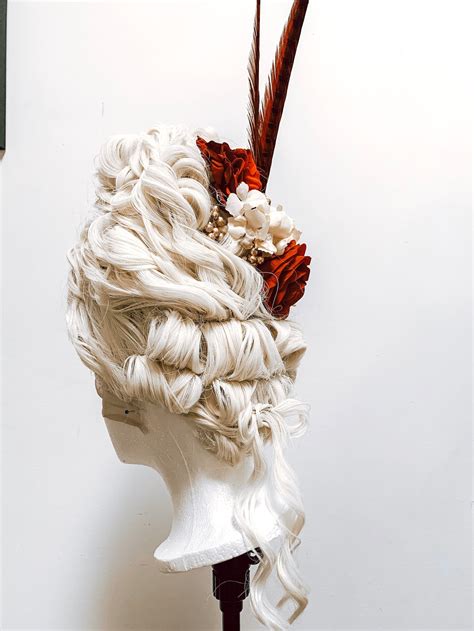Introduction
French powder wigs, an epitome of sophistication and extravagance, have captivated fashion enthusiasts for centuries. These intricate hairpieces adorned the heads of royalty, aristocrats, and the elite, symbolizing wealth, status, and the pursuit of beauty.

A Walk through History
17th Century: Origins and Evolution
The origins of French powder wigs can be traced back to the 17th century, during the reign of Louis XIV. Initially, wigs were worn to conceal hair loss and baldness caused by syphilis. However, as fashion evolved, wigs became an integral part of the royal court’s elaborate attire.
18th Century: The Golden Age of Powder Wigs
The 18th century marked the zenith of French powder wig fashion. Wigs grew to extravagant heights and were meticulously styled with pomades, powder, and ornaments. Each wig was a work of art, showcasing the skill of wigmakers known as “toupeurs.”
Types of French Powder Wigs
French powder wigs came in a myriad of styles, each designed for specific occasions and social status.
Bouffant: A towering wig that extended high above the wearer’s head.
Ramillies: A smaller and more practical wig with curled ends.
Queue: A wig with a long, braided tail that extended down the back.
Perruque: A general term for any wig that covered the entire head.
The Intricate Process of Wigmaking
Creating a French powder wig was a labor-intensive process that could take weeks or even months.
1. Human Hair Collection: Virgin human hair, often from young women, was collected from villages and towns.
2. Carding and Combing: The hair was carded and combed to remove tangles and create long, silky strands.
3. Weaving: The strands were woven together on a loom to create a wig base.
4. Curling and Styling: The wig was curled and shaped using hot tongs and pomades.
5. Powdering: A fine white powder, usually talc or flour, was applied to the wig to give it a distinctive white color.
Pain Points and Motivations
Pain Points:
- Itching and discomfort caused by the weight and tightness of wigs.
- Hair loss and damage due to tight tying and constant powdering.
- Social stigma associated with wearing artificial hair.
Motivations:
- Desire to conform to social norms and fashion standards.
- Emulation of the wealthy and powerful.
- Personal vanity and the pursuit of beauty.
Step-by-Step Approach to Understanding French Powder Wigs
1. Explore Historical Context: Understand the social, cultural, and political factors that influenced the development of French powder wigs.
2. Study Different Types: Familiarize yourself with the various styles, designs, and names of these iconic hairpieces.
3. Analyze Wigmaking Techniques: Learn about the intricate processes involved in creating French powder wigs, from hair collection to powdering.
4. Examine Pain Points and Motivations: Consider the challenges and reasons that drove people to wear these elaborate wigs.
5. Appreciate Cultural Significance: Recognize the enduring legacy of French powder wigs as symbols of sophistication, extravagance, and historical fashion.
Innovative Applications: Beautification and Beyond
Beautification:
- Inspired new hairstyles and hair treatments that enhance natural beauty.
- Influenced the development of modern cosmetics and hair products.
Beyond Beautification:
- Historical Research: Studying French powder wigs provides insights into past fashion trends and cultural values.
- Artistic Inspiration: The elaborate designs and craftsmanship of these wigs have inspired artists, designers, and fashionistas.
- Education: Powder wigs serve as educational tools for understanding 17th and 18th-century history.
Market and Statistics
Market Size:
The global market for period costumes and accessories, including wigs, is estimated at $766.4 million in 2022.
Consumer Demand:
- Demand is driven by increased interest in historical reenactment and costume parties.
- Social media platforms like Instagram and TikTok have fueled a surge in costume-related content.
Market Segments:
- Historical Enthusiasts: Individuals who participate in reenactment events and historical gatherings.
- Costume Designers: Designers who create costumes for movies, plays, and other productions.
- Fashionistas: Individuals who seek unique and eye-catching accessories to elevate their style.
Tables
Table 1: Notable French Powder Wigs
| Wig Style | Description | Wearer |
|---|---|---|
| Bouffant | Towering wig with a wide brim | Marie Antoinette |
| Ramillies | Smaller, curled wig | George Washington |
| Queue | Wig with a braided tail | Benjamin Franklin |
| Perruque à la Fontange | Elaborate wig with many tiers | Madame de Pompadour |
Table 2: Key Figures in French Powder Wig History
| Name | Role | Period |
|---|---|---|
| Léonard Bory | Wigmaker to the French court | 17th century |
| Patrick Toupet | Famous wigmaker in the 18th century | 18th century |
| Jean-François Laperruque | Leading wigmaker and inventor | 18th century |
Table 3: Pain Points Associated with French Powder Wigs
| Pain Point | Cause |
|---|---|
| Itching and Discomfort | Tightness and weight of wig |
| Hair Loss and Damage | Tight tying and powdering |
| Social Stigma | Wearing artificial hair |
Table 4: Motivations for Wearing French Powder Wigs
| Motivation | Description |
|---|---|
| Social Conformity | Adhering to fashion standards |
| Emulation of Elite | Imitating the wealthy and powerful |
| Personal Vanity | Enhancing beauty and self-expression |
